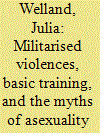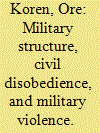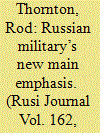| Srl | Item |
| 1 |
ID:
123382


|
|
|
|
|
| Publication |
2013.
|
| Summary/Abstract |
In recent years numerous reports of prisoner abuse and other militarised violences by British troops stationed in Iraq and Afghanistan have emerged. Drawing on two such incidents - the abuse of detainees at Camp Breadbasket and the murder of Baha Mousa - this article seeks to locate such violences on a continuum that can be traced back to the ways in which British soldiers are trained. Following on from a burgeoning feminist literature on militarised masculinities, and using Avery Gordon's epistemology of ghosts and hauntings, I suggest a conceptual and methodological intervention into the subject that resists generalised stories and the mapping of 'hard' borders. Focusing on the myths of asexuality and discipline that emerge from, and reinforce, the gendered discourses of basic training, I conduct a 'ghost hunt' of the haunting spectres that have attempted to be exorcised from these myths. Making visible these ghost(s) and tracing their (violent) materialisations through multiple sites and across a continuum, militarised violences - in all their ranges - begin to be made explicable.
|
|
|
|
|
|
|
|
|
|
|
|
|
|
|
|
| 2 |
ID:
133544


|
|
|
|
|
| Publication |
2014.
|
| Summary/Abstract |
In this article, I argue that factors inherent to the structure of a military organization and their relationship with the political leadership play a role in the organization's tendency to perpetrate violence against civilians during civil disobedience campaigns. To examine this hypothesis, I conducted a three-phased statistical analysis on a database containing 97 campaigns that took place between 1972 and 2012. In the first phase, I examined the relationship between military centric factors and violent crackdowns. In the second phase, I examined the relationship between military centric factors and mass killing. In the third stage, I examined the relationship between two specific types of discrimination in the military and mass killing. I found strong evidence supporting the hypothesis mentioned above. High-risk militaries that served a militarized regime, contained loosely regulated or indoctrinated paramilitaries, and discriminated against the protesting group, were much more likely to perpetrate violence against civilians during civil disobedience campaigns than low-risk militaries. The conclusions of this study suggest that further examination of the military's role in perpetrating violence against civilians during protests and conflict may provide some novel findings.
|
|
|
|
|
|
|
|
|
|
|
|
|
|
|
|
| 3 |
ID:
155710


|
|
|
|
|
| Summary/Abstract |
The nature of the Russian military threat to Western interests needs to be reassessed. An examination of articles in Russian military journals shows that its senior ranks now see ‘asymmetric means and methods’ as their new ‘main emphasis’ in modern peer-state wars. Rod Thornton explains that for them, winning such wars through asymmetric means has become a key way to impose Moscow’s will on other states. Remarkably, they seek to avoid the use of military violence.
|
|
|
|
|
|
|
|
|
|
|
|
|
|
|
|